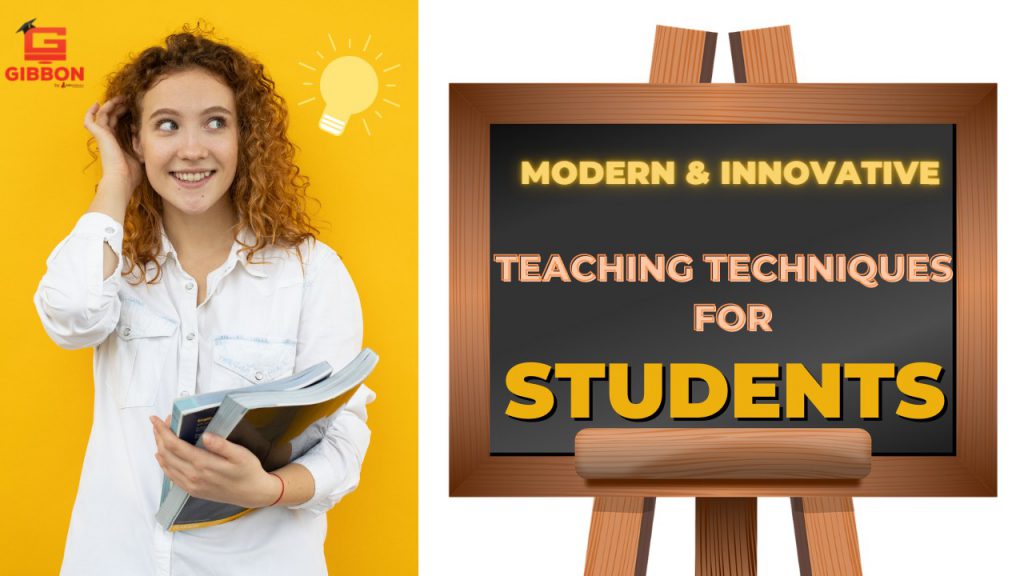There have been changes in teaching style over the years. In place of memorizing and the same old recitation exercise to educate the pupils, contemporary teaching methods and strategies, as well as interactive teaching tactics, were adopted, and the results can be observed.

This is an education reform that provides an altogether distinct viewpoint on teaching and studying since current teaching techniques, unlike the old approach to teaching, do not deal with all pupils at the same level of comprehending capacity. Modern teaching techniques, rather than being solely teacher-centered, place a greater emphasis on questioning, demonstrating, explaining, practical, and collaborative procedures, and are more activity-based.
There are several instructional methods available nowadays. Teaching has grown more advanced in today’s fast-changing world, and teaching institutes have recently used modern teaching techniques to handle students in a classroom. There are also several types of learning available today, such as distant learning, online learning, and traditional classrooms.
1. Context-Based Learning
Context allows us to learn from our experiences. We begin to comprehend the significance and meaning of new information by interpreting it in the context of where and when it happens and linking it to what we already know. The setting in a classroom or lecture theatre is often constrained to a fixed place and limited time. Learning can occur outside of the classroom by visiting a heritage site or museum, or by immersing oneself in a good book.
By engaging with our surroundings, conducting conversations, taking notes, and manipulating adjacent items, we have the ability to build context. We may also learn about context by investigating the world around us with the help of guides and measuring devices. As a result, designing teaching techniques and methodology in schools, museums, and online necessitates a thorough grasp of how context forms and is affected by the learning process.
2. Crossover Learning
Learning in informal venues, such as museums and after-school clubs, may connect instructional content to topics that are important to learners. These relationships are bidirectional. Learning at schools and colleges may be expanded by real-life experiences, and informal learning can be extended by incorporating classroom questions and effective teaching methods. These related events pique people’s interest and drive them to study more.
A successful way is types of teaching methods to present and discuss a subject in class, then for students to investigate that question through a museum visit or field trip, gathering photographs or notes as proof, and then sharing their discoveries back in class to provide individual or group solutions.
These crossover learning experiences take use of the characteristics of both environments and give learners real and engaging learning opportunities. Because learning occurs across a lifetime and draws on experiences from many contexts, the larger opportunity is to assist learners in documenting, connecting, recalling, and sharing their unique learning events.
3. Collaborative Learning
Previously, when learners were asked to revise a subject or syllabus during an exam or on a regular day, they would do so in isolation or in a room. In previous effective teaching methods, this practice was extensive. Colleges are developing collaborative learning to address this issue or to give an additional beneficial platform for students. Teachers form a group of learners in this current teaching style so that they may solve issues, discuss themes, and clarify their concerns. This promotes the development of social skills and allows students to grasp the subject more quickly.

4. Embodied Learning
Embodied learning entails the body’s self-awareness interacting with a real or simulated reality to help the learning process. Physical mobility is an evident aspect of effective teaching techniques while learning a new sport. The goal of embodied learning is for the mind and body to collaborate such that physical input and actions enhance the learning process.
Wearable sensors that collect personal physical and biological data, visual systems that detect movement, and mobile devices that respond to activities such as tilting and motion can all help with this. This method of teaching in education may be used to examine physical sciences such as friction, acceleration, and force, as well as simulated circumstances such as the structure of molecules.
For more broad learning, the method of physical activity allows learners to participate in emotion while learning. Being more conscious of how one’s body interacts with the world can also help to foster the development of a mindful attitude to learning and well-being.
5. Adaptive Teaching
Every learner is unique. However, the majority of instructional presentations and resources are the same for everyone. This causes a learning difficulty by placing the onus on the learner to find out how to interact with the knowledge. It implies that some students will be bored, some will be perplexed, and very few will find pathways through the information that result in optimal learning. Adaptive and effective teaching methods provide a solution to this issue. It creates a customized path through educational content using data from a learner’s prior and present learning.
Adaptive teaching methods and strategies suggest the optimum places to begin new information and when to revisit previous knowledge. They also give a variety of tools for tracking one’s development. They extend long-standing learning techniques, such as textbook reading, by adding a layer of computer-guided assistance.
Data such as reading time and self-assessment ratings may be used to guide each learner through instructional resources. Adaptive teaching can be used in the classroom or in online venues where students can study at their own speed.
We cannot tell which pedagogical approach to teaching is superior after careful examination of many teaching methods and strategies! Both conventional and modern teaching styles have advantages and disadvantages. They are similar yet also distinct from one another. Modern teaching methods and strategies must embrace conventional teaching strategies as their foundation, and students must not entirely disregard them while adding new ones.
ABOUT GIBBON
Gibbon is a Plug and Play solution offered by EduGorilla, for anyone with a skill to teach. Gibbon helps you to take your classes online and earn independently.
- Gibbon gives you the ability to conduct & record LIVE classes, host unlimited video courses, provide online mock tests, and conduct online tests with LIVE proctoring abilities.
- Gibbon also provides you ready-made content of 1600+ Competitive, Entrance, and Academic exams from around the country.
- Gibbon helps you reach out to more students online and get a complete marketing setup.
- We have helped more than 3000 Brands, 10000 Institutes, 20000 Teachers and 2 Crore Students, transform their education and future.
Gibbon stands for “Online-Ready Teachers for a Future-Ready India”.
To get started, book your free demo now.






